
The man who would be the father of not just a country, but more broadly of a good portion of an entire continent, Simón Bolívar was born to a fairly wealthy family in Caracas—then part of Spain’s New World empire as the Viceroyalty of New Granada. Both of his parents died before he was nine, and the upbringing of the young Bolívar was left to the family slave, Hipólita, as well a tutor, Don Simón Rodríguez. It was under the tutelage of the latter that Bolívar developed a love for the ideals of liberty and freedom, as well as the enlightenment movement. Somewhat foreshadowing Bolívar’s own role as a thorn in the side of imperial Spain, Rodríguez was forced to leave the country following accusations of a conspiracy against Spanish rule in the viceroyalty.
When just 17, Bolívar left his homeland and traveled to Spain to continue his education, staying in Madrid for two years before returning home. Another stint in Europe came just two years later in 1804, whereupon he took in even more of the liberalism instilled in him by Don Rodríguez. His second return to the viceroyalty would be much more eventful, as Caracas, and the entirety of Spanish claims in the New World, would begin to change forever.
A coup in 1810 allowed for the creation of Venezuela through a junta, with Bolívar serving as a delegate to Great Britain in order to secure aid and recognition. While the ensuing republic was short-lived, falling to royalist forces in 1812, Bolívar later accepted a military position with the United Provinces of New Granada, a similar rebellious faction focused to the west in what is now Colombia. It was under this banner that Bolívar began his “Admirable Campaign,” and first garnered the nickname of El Libertador (the liberator), marching from city to city to drive out royalist support. He was critical in the taking of Caracas, allowing for the establishment of the Second Republic of Venezuela, though this was short-lived as well. A Third Republic would follow, which would ultimately be succeeded by the state of Gran Colombia, a republic that would comprise much of modern-day Colombia, Ecuador, Panama, Venezuela, northern Peru, western Guyana, and northwestern Brazil, and for which Bolívar would serve as the first president—in office from 1819-1830.
During this tenure, he continued his pursuit of liberation for his peoples, marching south into Peru, where the congress there appointed him to be dictator, allowing him to make vast structural changes to the fledgling nation’s military and government administration. Meanwhile, at the Congress of Upper Peru, another new nation was created, this time drawing her name from the liberator himself, Bolivia. Toward the end of the decade, the strain of administering this vast band of nations became apparent, as smaller factions vied for power and tensions between neighbors intensified. Bolívar’s dream of a unified Hispanic America was not to be, with Gran Colombia yielding to many of the political borders that we know today. Nevertheless, the role of Bolívar as the liberator of the northern and western halves of South America is undeniable. After contracting tuberculosis, Bolívar died in 1830 at the age of just 47 in Santa Marta, now northern Colombia.
Reflecting the degree to which Bolívar is celebrated in Latin America, our October Collectors Choice Online (CCO) auction will present selections featuring the portraits of the famous liberator. The most iconic is found among the coinage of Venezuela, which features the head of Bolívar and has bestowed his name on the nation’s unit of currency. Continuing to bear his portrait to this day, the coinage that garners much of the numismatic focus is the 5 Bolivares issues of the late 19th century to early 20th century, along with its minors. Avidly collected by dates and varieties, our sale will offer an extensive run of these types, satisfying the expert as well as the novice. In addition to Venezuela, Bolívar is observed on the coinages of Bolivia and Colombia, as well as a host of various one-offs celebrating or paying homage to this important figure in the South American nationalism.
To view this vast collection focused around “El Libertador” along with the rest of our October Collectors Choice Online (CCO) auction, please visit StacksBowers.com website where you may register and participate in this upcoming sale.
We are always seeking coins, medals, and paper money for our future sales, and are currently accepting material for our Official Auction of the N.Y.I.N.C. in January 2020. Following that, our next Collectors Choice Online (CCO) auction will be in February 2020. If you would like to learn more about consigning, whether a singular item or an entire collection, please contact one of our consignment directors today and we will assist you in achieving the best possible return on your material.





